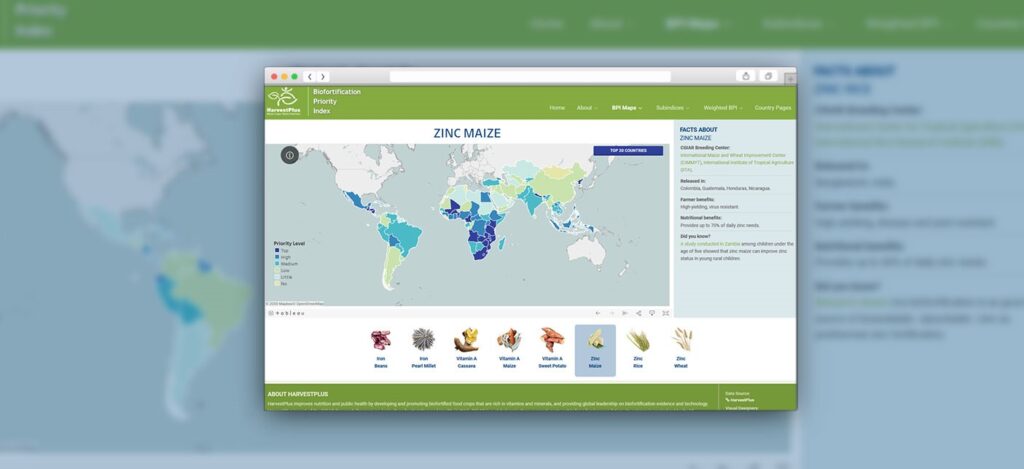A new interactive tool helps identify where and for which staple crops biofortification can make the greatest impact on micronutrient deficiencies.
The website, based on the HarvestPlus Biofortification Priority Index (BPI), is a user-friendly tool designed to guide strategic decisions for investment, policy, and practice pertaining to the introduction and scaling of biofortified staples.
Biofortification targets rural families in developing countries relying on homegrown, inexpensive but not very nourishing staple foods like rice, wheat, or maize. The biofortification process allows rural families to grow and consume varieties of these crops that are rich in vitamin A, iron, or zinc—three of the micronutrients identified by the World Health Organization as most critical for health.
HarvestPlus developed the BPI in 2013 to ensure efforts to develop and deliver biofortified crops by HarvestPlus and its partners were as targeted, cost-effective, and impactful as possible. Using the most recent national-level data on eating and growing patterns as well as micronutrient deficiency rates, the BPI ranks 128 countries in Africa, Asia and Latin America and the Caribbean regions according to their potential for biofortification for eight different crop-micronutrient combinations. The result is a clear prioritization of where biofortified crop interventions are most suitable.
“The BPI provides us with the information of where malnutrition is at its worst but also where biofortified crop are available and can make the biggest impact,” said Brian Hilton of partner organization World Vision. “Our food-based approach to resolving malnutrition in the poorest countries requires a decision-making tool like the BPI.”
For example, given production and consumption patterns and iron deficiency rates, Niger is the top country for development and delivery of iron pearl millet—and the first variety was released in 2018. Bangladesh ranks first for zinc rice and now has eight varieties released. Pakistan ranks first for zinc wheat and has one variety to promote. Malawi, first for vitamin A maize, has ten biofortified varieties released to date, while number two Zambia has six. Burundi ranks first for iron beans and has two varieties, while Rwanda, which comes second, has ten varieties of iron beans available for farmers and consumers.
As more evidence on the efficacy and cost-effectiveness of biofortification becomes available, stakeholders are increasingly interested in the solution. “HarvestPlus’ aim is to catalyze the scaling up of biofortification with a goal of reaching one billion people with biofortified foods by 2030,” said Dorene Asare-Marfo, Head of Knowledge Management at HarvestPlus, the team which developed the tool. “Strategic tools such as the BPI are pivotal in informing scale-up decisions and partnerships.”
The launch of the second version of the BPI tool, now on a dedicated website, follows two years of work to update the data and analyses behind the index, and to improve the applications/functions of the tool.
Users can:
- Quickly identify the 20 countries most suited for biofortification of each crop.
- Take a closer look at the data behind the index with interactive maps for the subindices—production, consumption and micronutrient deficiency.
- Learn more about the progress being made to test and release biofortified crop varieties in each country.
- Compare how rankings change when a country’s land area or population size is considered.
- See the BPI for the newest biofortified crop: zinc maize.
“Biofortification and large-scale food fortification are both evidence- and population-based interventions which are driving forward improved intakes of essential vitamins and minerals,” said Greg Garrett of partner organization GAIN. “HarvestPlus’ Biofortification Priority Index helps GAIN and others involved in micronutrient programs better track global progress in rolling out these interventions and to do so in a more complementary way.”
Visit the site to learn more.
